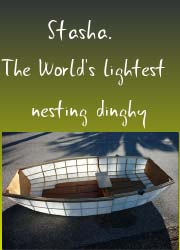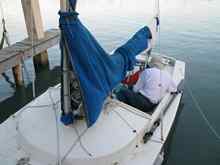| Part One - Part Two - Part Three - Part Four - Part Five
On Sunday morning we headed to the skipper's meeting at 8am. It was a short meeting. I then drove the Jeep and trailer up to Seadrift, Texas where the 6 days of sailing was going to end. While I was driving up there, Bill was going to get our non-perishable provisions and gear (other than personal items) aboard the boat and get it ready to leave Monday morning. I got the Jeep and trailer up to Seadrift, had lunch and boarded the bus for the return trip to Port Isabel. A bus was provided by the event for a return to the start point.
Monday morning, the first day of sailing, we got up early and finished putting our food, coolers, and clothing dry bags in the boat. The Day Sailer cuddy cabin appears to have a lot of room in there until you get it packed with water, provisions and camping gear for six days of sailing. It fills up quickly. We then got our water and energy bars for the day in the seat icebox and a small cooler in the stern. We also hooked up the solar panel and battery for recharging the handheld VHF radio, cell phones, etc.
Thirty-five boats were supposed to be starting that morning from Port Isabel. We were the second to the last boat to start. Our first days' sail was about 43 miles to the first camping place. Most boats got out very early. One boat didn't start at all due to a medical problem of the skipper. It was found after he went to the hospital that he was suffering from dehydration. A gallon of water per person per day is recommended for this event. We had 14 gallons of water on board at the start. This year with temperatures near 100 at the hottest part of the day, this is very important. In previous years the temperatures were in the low 90's.
It was suggested to us that we start out with a double reef in the mainsail as winds were expected to get stronger throughout the day. As it turned out we had a double reef in the main for the whole trip. We headed out of the harbor and in to the Laguna Madre and turned north. We were sailing up the Intracoastal Waterway (ICW). A few boats had decided to take the outside route in the Gulf. Our first camp at the Port Mansfield Jetties could be reached by both routes. We followed the marked channel. The channel is well marked with buoys on each side along with spoil islands and obstructions (both above and below the water). I also had my GPS loaded with our waypoints and we had a set of maps with both NOAA maps and 2010 vintage aerial photography.
I had a compass as well, but forgot to mount it. It got buried in the cuddy cabin somewhere. To the east of the channel was very shallow water (3-feet or less) with rocks and mud, a lot of mud. It was a little deeper water to the west of the channel, but not much, and of course, mud. I was at the helm the first few hours, and then Bill took over to give me a break. The boat immediately picked up speed. I'm a big man, Bill weighs half what I do. We found the boat was faster with me up near the cuddy cabin, so from that point on, Bill was at the helm, unless he needed a break. I was navigator (and sometimes bailer). I knew the charts better so it was a good fit.
Most of Monday was not very eventful for us. We mainly got used to sailing together and adjusting rigging and sail trim. As the day went on we started getting more speed out of the boat. The boat that left ahead of us stayed the same distance ahead. The last boat out, a Goat Island Skiff named GIR, was a very fast boat. The boat was sailed by the man who built it and the designer, Michael Storer who came up from Australia for the Texas 200.
The wind continued to build all afternoon, mostly from the south to south east. When we got near Port Mansfield, the wind was getting very strong. We started to make our turn to the east to reach Camp 1 at the Port Mansfield Jetties. The wind had also shifted to the east and increased in strength. We were having trouble staying in the channel. Due to the very strong winds we dropped the jib using the jib downhaul I had rigged for this event. The downhaul worked very well and kept us from having to get on the foredeck to bring down the jib. We were having a hard time making headway. We noticed other boats having the same problem. Some radioed that they couldn't make it to Camp 1 and were heading into Port Mansfield instead. Those with outboards were dropping their sails and motoring towards Port Mansfield. They were having trouble going into the strong east winds. Port Mansfield was to the west. We only had oars as an auxiliary. In light to moderate winds the oars work well, but in the strong wind we had they weren't an option. We noticed two catamarans beached on a small spoil island along the channel. We headed for them.
We beached the boat on the island. Spoil islands in this area typically have muddy shorelines. Our little island was no exception. Bill got out of the boat and sank over a foot in mud. When I started to get out I slipped over backwards catching my foot on a line. My head was pushed under water. I called for help and one of the catamaran guys untangled me and pulled me out. The mud was so deep I had trouble standing. I'm a heavy guy; I sank deeper than the others in the mud. We decided this was going to be our camp for the night despite the dead birds everywhere, cactus, and what looked like some prime rattlesnake areas. Yes, rattlesnakes get out to and live on the spoil islands.
We pulled the boat up as much as possible and set our anchor on shore. Not having any good place to sit on shore (there were no trees) other than the small spot I found with cactus thorns (I found them the hard way), I did what ended becoming a daily habit for me, I took a nap on the boats fore deck. I found I could get comfortable up there with my legs on the cuddy cabin and the jib over my face to prevent sunburn. Bill tried to clean mud from the boat and scout out a place for his tent. When I got up from my nap, I helped Bill clean some mud off the boat. We sent out a message on the VHF radio to let others know where we were for the night. The fleet was scattered all over the area. Eventually I put up my tent and settled in for the night like the others had. |







